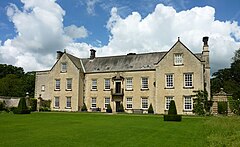Nunnington Hall
| Nunnington Hall | |
|---|---|

South elevation
|
|
|
Location within North Yorkshire
|
|
| General information | |
| Type | Manor house |
| Location | Nunnington, Ryedale, North Yorkshire, England |
| Coordinates | 54°12′20″N 0°58′26″W / 54.205432°N 0.973783°WCoordinates: 54°12′20″N 0°58′26″W / 54.205432°N 0.973783°W (grid reference SE6779) |
| Owner | National Trust |
| Website | |
| www |
|
|
Listed Building – Grade I
|
|
| Designated | 14 July 1955 |
| Reference no. | 1168075 |
Nunnington Hall is a country house situated in the English county of North Yorkshire. The river Rye, which gives its name to the local area, Ryedale, runs past the house, flowing away from the village of Nunnington. A stone bridge over the river separates the grounds of the house from the village. Above, a ridge known as Caulkley's Bank lies between Nunnington and the Vale of York to the south. The Vale of Pickering and the North York Moors lie to the north and east. Nunnington Hall is owned, conserved and managed as a visitor attraction by the National Trust.
The first Nunnington Hall was mentioned in the thirteenth century and the site has had many different owners. They include William Parr, Dr Robert Huicke, Richard Graham, 1st Viscount Preston, the Rutson family and the Fife family. The present building is a combination of seventeenth and eighteenth century work. Most of the building seen today was created during the 1680s, when Richard Graham, 1st Viscount Preston, was its owner.
It was William Parr, 1st Marquess of Northampton, brother of queen consort Catherine Parr, who built the oldest parts of the surviving house of Nunnington, which now form part of the west front. Following the forfeiture of the estate after his death in 1571 (for his part in setting Lady Jane Grey on the throne), Nunnington was again subject to let. One of the tenants was Dr Robert Huicke, who was physician to both Catherine Parr and Elizabeth I. Dr Huicke was to be the one to tell the Queen that she would never have children. Huicke never lived at Nunnington however and the estate was managed by stewards. The sub-lease was granted to Thomas Norcliffe in 1583 and the family made many alterations over the next sixty years.
...
Wikipedia

